This article was published in the Bloomberg Weekend Edition (© 2025 Bloomberg L.P.) on January 8th, 2025. Written by By Jinshan Hong, Josh Xiao, K Oanh Ha, and Danny Lee, with assistance from Spe Chen, Adrian Leung, and Jane Pong. Guy Rubin, founder of Imperial Tours, was a source used for this article.
The billions of dollars in spending that an unprecedented lifting of visa requirements could have brought simply hasn’t materialized.
China took the unprecedented step of easing visa requirements for scores of countries in 2024, now throwing open its doors to 1.9 billion would-be visitors. Only a fraction of the hoped-for tourists have come.
The influx of foreign tourists and the billions of dollars in spending they could have brought simply hasn’t materialized, a Bloomberg analysis shows. Visitors from the US and most of Western Europe — where political and trade spats with Beijing abound — stayed away. Instead, tourists from nearby Asian countries and less-developed markets came calling.
Foreign visitor entries to China totaled just under 23 million in the first three quarters of the year, according to a Bloomberg News analysis of the most recently available government data. While that’s roughly double 2023’s low base, it’s still only 63% of 2019’s same-period level and well short of the near full recovery Beijing would have been hoping for as it slashed red tape.
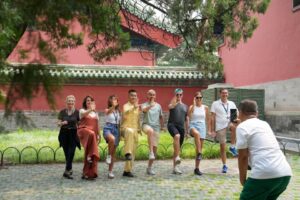
Italian tourists pose for a group photo after practicing tai chi at the Temple of Heaven Park in Beijing in July 2024. Photographer: Ju Huanzong/Xinhua/Getty Images
The reasons are manifold; far fewer international flights from overseas airlines, changing economic and political ties and a deteriorating perception in the West of China. For Beijing, the ramifications will limit its ability to prop up a sluggish economy and facilitate investment. It’s also a failed opportunity to project a better image abroad before tensions flare again as President-elect Donald Trump returns to the White House.
“China’s overall attractiveness as a tourist destination, and as a business destination, has been damaged because of Covid, Beijing’s policies and geopolitics,” Bloomberg Intelligence senior aviation analyst Tim Bacchus said. “The visa-free policy helps on the margins but it’s not making up for the fact that people are pivoting away from China.”
The precipitous drop in foreign visitors after the pandemic prompted China to unfurl the welcome mat in its biggest-ever tourism push. In the two years to the day since China re-opened its borders, Beijing has unilaterally relaxed visa policies to an ever-widening number of countries, despite its historical preference for reciprocal visa-free access.
China has now unilaterally extended visa-free entry to citizens of 38 countries. Before the pandemic, going to China sans paperwork was only allowed unilaterally for those from Singapore, Japan and Brunei. Beijing has also broadened a policy of offering visa-free entry for transit travelers who plan visits of 10 days or less. That currently applies to 54 nations.
“The fact they’re providing visa waivers to some countries’ citizens without reciprocity shows some level of desperation,” Bacchus said.
China’s Ministry of Culture and Tourism didn’t respond to a request for comment.
With a looming US trade war threatening Chinese exports, luring back foreign spenders is a critical pillar of President Xi Jinping’s grand plan to revitalize the world’s No. 2 economy. Beijing is battling its longest deflationary streak since 1999 as domestic brands are mired in price wars and Chinese consumers clock one of the world’s highest household savings rates.
Majority of China’s Visa-Free Perks Go to European Nations
Failure to convince Western travelers that China is a worthwhile holiday destination also risks deepening an isolation Beijing began when it closed its borders for three years during the pandemic. Since then, a series of trade spats have erupted between China and many Western democracies, with those hostilities now being reflected in a near decoupling of tourism ties between the Asian nation and the US and its allies.
Worryingly, the tourists China is attracting with its visa-free policies aren’t the big spending ones. At their peak in 2019, international visitors poured $132 billion into China, research by the World Travel & Tourism Council in partnership with Oxford Economics show. The organization estimates foreigners only opened their wallets to the tune of $98 billion in 2024, a 26% drop.
Guy Rubin, who founded Imperial Tours with his wife Nancy Kim in 1999, said his American clients now make up just under 40% of business compared with about 90% before Covid. Imperial Tours offers luxury travel throughout China, billing itself as a way to explore the nation’s heritage and high-end restaurants and hotels in style.
“Americans are generally scared of China,” said Rubin. “People individually say they’re not affected by geopolitics but we see very clearly the degree to which that’s untrue.” From dealing exclusively in China travel, Imperial Tours has had to add South Korea to the mix.
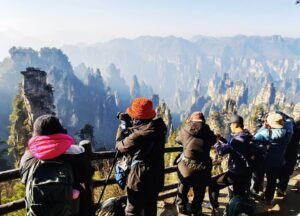
Photographers at the Zhangjiajie National Forest Park in Hunan Province on Jan. 5.Photographer: Deng Daoli/VCG/Getty Images
Rubin also said many Americans find the visa process “really tiresome.” “Our US travelers are taking advantage of the transit visa waiver programs, but we have to spend a fair amount of time explaining how they work.” Instead, healthier demand is coming from countries with better trade flows with China, like the Middle East, he said.
Even the people who are being drawn to China — of the almost 23 million foreign arrivals in the first nine months of last year, only a little over half, or 13 million, entered visa free — have initial reservations.
Alexandre Vadot, a finance analyst based in Tokyo, was one of them. The 28-year-old Frenchman traveled to Shanghai for a week in March in his first-ever trip and followed that up with another visit to Beijing in September.
While China was a lot more advanced than he thought, some things rankled, like people cutting queues. “When you’re born and raised in France or Europe, you have a not favorable image of China” based on media coverage, Vadot said.
At a national level, China doesn’t break down its tourist arrivals by country, but a Bloomberg Intelligence analysis of data from flight and ticketing analytics firm ForwardKeys, shows it’s people from China’s closest neighbors taking the most advantage. Round-trip bookings to China from Malaysia surged 69% in 2024 versus 2019, while those from Thailand increased 30%.
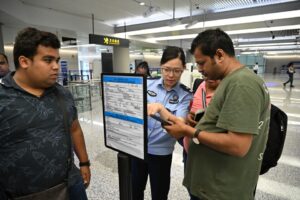
A staff member assists foreign travelers at Shanghai Hongqiao International Airport in August 2024. Foreign visitor entries to China totaled just under 23 million in the first three quarters of the year.Photographer: VCG/Getty Images
And despite most visa-free perks going to rich European nations, it hasn’t brought a crush of visitors. Round-trip bookings from both Germany and France plunged 38% while Italy sank 29%.
Xi is acutely aware of the benefits that having visitors witness the real China — one that is largely safe, cosmopolitan and rich in history — for themselves can bring. Speaking in San Francisco in November 2023 during a low point in China-US relations, Xi said that the more difficulties there are in the world, the “greater the need for us to forge a closer bond between our peoples and to open our hearts to each other.”
A closer look into tourist arrivals in Beijing, which does break down data by some nationalities, hints at what’s likely being reflected across the country. Around 10% of foreigner entries to China make a tourist stop in its capital city.
Similar to the round-trip flights booking data, it shows an influx of visitors from Malaysia and Vietnam, as well as Russia, probably as Russians find other destinations off limits due to sanctions. Canadians, the Swiss and the Germans are steering clear.
| Tourist Origin | % Change from 2019 to 2024 | |
|---|---|---|
| Vietnam | 283% | |
| Mongolia | 224% | |
| Russia | 158% | |
| Malaysia | 109% | |
| Thailand | 62% | |
| Indonesia | 46% | |
| Singapore | 24% | |
| Spain | 16% | |
| Pakistan | 8% | |
| Italy | 7% | |
| Myanmar | -7% | |
| North Korea | -12% | |
| Total foreigners | -18% | |
| New Zealand | -23% | |
| France | -27% | |
| Germany | -27% | |
| UK | -32% | |
| India | -36% | |
| Canada | -37% | |
| Japan | -40% | |
| Philippines | -43% | |
| Australia | -43% | |
| Sweden | -48% | |
| Switzerland | -49% | |
| South Korea | -51% | |
| US | -52% |
Source: Beijing Municipal Bureau of Culture and Tourism, Bloomberg
Note: Figures are adjusted by Bloomberg to account for a methodology change with the official data in June 2024. Both 2024 and 2019 data are from January to November.
One practical reality that’s limiting visitors is a dearth of flights, at least from international airlines. In 2024, international flights to and from China returned to 74% of 2019 capacity, according to data from aviation analytics firm Cirium. Among these cross-border connections with China, foreign carriers have resumed only 58% of their pre-Covid capacity, overshadowed by an 88% recovery rate by Chinese carriers.
European carriers can’t use Russian airspace and apart from taking a lot longer, flying around Russia incurs significantly higher fuel costs. Many have slashed their China schedules because that, combined with the lack of demand, makes the routes unprofitable. The airspace restrictions don’t apply to Chinese carriers, which have quickly filled the gaps left by exiting foreign airlines.
Even trips that don’t use Russian airspace aren’t particularly viable due to people’s limited interest in going there. Japan Airlines Co. Chief Financial Officer Yuji Saito said inbound travel to China is still only about 40% of pre-pandemic levels. “We think that will continue,” he said, describing it as the “new normal.”
Other airlines that have operated for decades in China have exited outright. Virgin Atlantic Airways Ltd. pulled out in July while Lufthansa, Scandinavian Airlines, Qantas Airways Ltd. and British Airways have also canceled routes as they became financially unsustainable.
“The market just isn’t there,” Cebu Pacific Chief Executive Officer Mike Szucs said. The Philippine airline has also dramatically cut back flights.
Shifting economic ties are a big reason behind the subdued demand. Western companies have been hesitant to ramp up investments in China due to growing regulatory complexity and geopolitical tensions, and that’s hampering travel too. Business travel bookings to China were just 52% of 2019 levels versus leisure bookings’ 79% recovery last year, the analysis of ForwardKeys data shows, and people who are traveling for work aren’t staying on to enjoy what else China offers.
Savanti Travel, a company specializing in business bookings, used to organize a lot of trips into China for international executives.
“Now, those meetings are in Tokyo or Seoul and they’re headed to other parts of Japan or Bali after their work trip,” founder Leigh Rowan, who used to run popular website The Points Guy, said. “It’s fundamentally changed.”
Around the world, people’s views of China have evolved, with fewer citizens from developed nations likely to hold positive views of the country’s economic impact and military prowess, according to a Pew Research Center survey.
Tourists from Japan, for example, are wary after a spate of attacks on Japanese citizens while those from the US and Canada, where anti-China sentiment has deepened, have noticeably stayed away. Washington and Beijing remain locked over a range of hot-button issues like Taiwan and the South China Sea, which is undermining business confidence and putting a lid on grassroots exchanges.
Airline logistics and geopolitics aside, China still remains a daunting place for many. English isn’t widely used even in hubs like Shanghai and Beijing, and the nation has its own mobile payments system that discourages cash and can be tricky to figure out without learning Mandarin. The internet is also heavily censored so sites like Google or Instagram can’t be accessed.
Claire Thum, a 27-year-old interior designer from Singapore, started to notice more social media videos featuring diverse landscapes and life in China. But despite a largely favorable impression of China in the small island nation, she’s held off from a trip, intimidated by the technology complications and language barrier.
“There are still a lot of hurdles to jump over.”
How To Sort Out Your China Tourist Visa
From 2018, in the years leading to the Covid pandemic, China unfurled in step-wise fashion a global tourist visa application program that was as bureaucratic as it was prickly. But since the end of the pandemic, coinciding with her rising economic woes, China’s been accelerating in the exact opposite direction. Recently, it’s become far more flexible and welcoming to foreign travelers. Read on to find out how.
China Loosens Its Visa Rules For Western Europe and Asia
China’s visa loosening began in July 2023 when it resumed visa free travel for citizens from Singapore, Brunei and Japan. Then, on December 1, 2023 it extended this in a total first, allowing citizens from France, Germany, Italy, the Netherlands, Spain, and Malaysia to travel under the same conditions – namely for up to 15 days visa-free in the country.
A month later, on January 1, 2024, China relaxed considerably the documentation that US-based travelers need to provide with their tourist (L) visa application and they also shortened the online application by about two pages.
Then, on January 11, China made it possible to get a visa on arrival at the airport, as described below, and – as if that wasn’t enough – a few days later, it qualified Swiss and Irish passport-holders also for visa-free travel!
China Makes It Easier For US Residents To Get A Tourist Visa
The process now in the USA is for travelers to fill out an online application and take this together with their passport, a passport photo, driver’s license (proof of address), an application fee and a “where you stay” form to the Chinese consulate responsible for their state. Although the online application form at 9 pages is shorter than it used to be, it is still pretty detailed. One section asks about travelers’ intended itinerary. Previously, applicants had to provide plane tickets and hotel confirmations attesting to this itinerary. However, this requirement is now removed and all applicants need do is describe their intended itinerary with no commitment whatsoever to performing it, i.e. you can change your itinerary as needed after the fact. If all the forms have been completed correctly, after 9 – 12 business days, a 10 year multi-entry L visa will be provided to you.
A Quick Note For All Business Travelers – New Possibility of Visas on Arrival!
On January 11, 2024, China relaxed its visa rules a little more, but it only offers an advantage for non-leisure travelers, principally business travelers and so I include only a brief mention here. If a traveler has an urgent need to visit China, say for business, and not enough time to sort out a business visa, what they can do now is jump on an international flight to China and make their case to the customs police at the airport once landed. (They will likely need a detailed, stamped letter from a Chinese company attesting to their situation effectively acting as an invitation letter.) If you can provide the right documentation, depending on your circumstances, then the airport customs police now have the latitude and authority to issue you with a 24, 72 or 144 hour visa so that business people can take care of urgent affairs in China.
It Remains Onerous To Get A China Visa In The UK, Brazil, Argentina and Mexico
To get an idea of how favourable the new policy is for US residents, compare it with how unfavourable the policy remains for UK residents. British applicants must still travel to a visa centre – whether Manchester, Edinburgh or London – to have their finger prints scanned, the policy since 2018. As well as a completed application form, a photo and an application fee, they continue to be required to provide hotel and plane confirmations coinciding with the itinerary they outline in the application form. The requirement to undergo the finger print scan together with the requirement for plane and hotel confirmations means that the UK application process is more onerous than the one in the US, and of course many western European countries don’t even require a visa now. We are hopeful that the visa application process will loosen in the UK, Mexico, Brazil and other countries in the next couple of months. Should this happen, we’ll update agents in an email blast.
Should You Use a Visa Service?
I find myself baffled by seemingly pointless bureaucracy, and so find the visa application process tremendously off-putting. As a result, I always get an agency to deal with my visa applications and I would recommend others do the same. In the US, Imperial Tours has co-operated with Passport Visa Express for many years. (Back in the day, I used to be able to phone them up and get VIP’s next day China tourist visas, but those times have now sadly passed.) In the UK, we work with Cultural Tours, an outfit informally linked through the Chinese network to CTS (UK), a state-owned travel company.
The advantage of using a visa agency in the US is manifold. Most practically, they will “walk” your application into the consulate for you so that you don’t have to go there yourself. Secondly, you can choose between one of two services. Either (i) you get them on the phone and they fill in the form for you (heaven sent!) or (ii) after you fill in your online form but before submitting it into the consulate’s computer system you save a copy onto your PC and email this version to them so that they can check it to ensure you’ve answered all the questions correctly before submitting it, thereby saving you the complications and delay of an incorrect or incomplete application. The third benefit of working with them is in eliminating much of the back and forth in the application process, giving you both more confidence in the visa system and in getting your visa back in good time for your travels.
These days, Passport Visa Express‘ normal service takes 9 – 12 business days and their premium service takes from 6 – 8 business days. (The super-fast 1 – 2 day turnaround time is currently unavailable.)
Cut To The Chase Already!
Long short, if you live in much of western Europe or the US, getting a tourist visa to China is pretty straightforward these days.
In May 2023, during my first visit to China after the pandemic, I was astonished by the development of Xi’an. “How Has Covid Changed China” chronicles the transformation of this previously unkempt city into a more modern metropolis of gleaming towers and high-tech zones interconnected by elevated expressways, metro lines and buses set on a canopy of lake-centred parks and green spaces. It was like time-traveling from 1980 to 2025 in the space of four years.
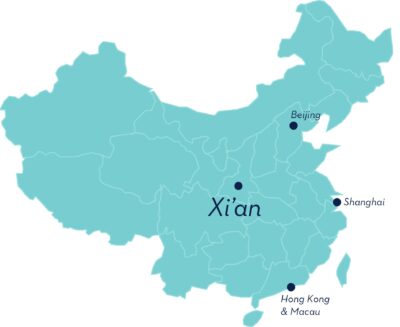
To understand the forces behind Xi’an’s incredible leap over the past five years, we need to look at government policy towards Xi’an over the past forty years, but particularly either side of the launch of the Belt and Road Initiative (BRI) of 2013. Prior to the BRI, exports routinely traveled from China to the rest of the world eastwards by ship. And as Xi’an is in western China, she was facing irrelevance and obsolescence.
China’s reforms of the 1980’s had led to a widely-celebrated economic boom along the east and south coasts where customs-exempt manufacturing zones located by rapidly growing ports were exporting a range of low-cost goods around the world. Meanwhile, because of poor inland infrastructure, foreign investors shied away from Xi’an which subsequently suffered slow growth and emigration. This imbalance was addressed by President Jiang Zemin’s “Go West Campaign” of 1999 which between then and 2006 prompted public investment of more than ~US$140 billion in transport, energy and connectivity to develop the attractiveness of western regions for investment. To forestall inevitable environmental complaints about this steel-woven carpet of concrete infrastructure, ecological protection along with education, were incorporated into the policy from the outset – over a million hectares of farmland and wasteland were converted into forest with farmers compensated for their resulting loss of income.
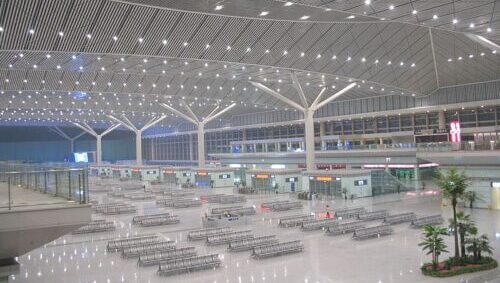
This long-term planning, a characteristic of Chinese governance, from two-decades ago is coming to fruition now. Apart from building smart new highways for China’s burgeoning middle classes and road-hauliers, a second airport terminal was completed in 2003 and a third in 2012. Also, Xi’an’s connection to China’s expansive high speed railway system, the largest in the world, was facilitated through the construction of Xi’an North Station. And again with an eye on the environment, investment was planned for a city metro system whose 9 lines covering 263 miles (423 km) opened between 2011 and 2023.
However, this first phase of development, pre-BRI, received a disappointing response from foreign investors. On the one hand, this was because the strategy had all been directed by the government which made western business people uncomfortable, and on the other, it was because it was ultimately misdirected. The billions spent on improving the infrastructure and educating the local workforce still did not compensate for the easy convenience of locating manufacturing capacity in the vicinity of the already established shipping hubs with their teaming populations.
This state of affairs was to be radically changed by President Xi Jinping, whose hometown is a one-hour drive from Xi’an. In 2013 he launched the Belt and Road Initiative (BRI), prompted by three separate factors. Firstly, China still needed to address the longstanding economic imbalance of its underperforming western regions. Secondly, Xi realized that China’s reliance on shipping for all its exports created a significant trade, economic and military vulnerability – any geostrategic rival could bring China to its knees by blockading the Malacca Straits through which nearly all China’s shipping passed. Lastly, as a result of the massive stimulus it unleashed following the 2008 financial recession, China had developed over-capacity in infrastructure-related capabilities, particularly in steel and concrete production. Coupled with a need to diversify its asset holdings from an over-reliance on US bonds, it saw an opportunity to leverage its infrastructural know-how through an international development loan and export program.
So what is the oddly-named Belt and Road Initiative? (BRI for short) Translated uncomfortably from the Chinese, “belt” and “road” refer to two different sets of envisaged trade routes. “Belt” describes the web of historic overland trading routes popularly referenced as the “silk road” linking Europe and China via Mongolia, Russia and Central Asia. This ancient commercial network has already been significantly rejuvenated through a gargantuan Chinese-built infrastructure program and even now continues to receive more investment from both China and participating countries. Xi’an has always been at the Chinese terminus of that network.
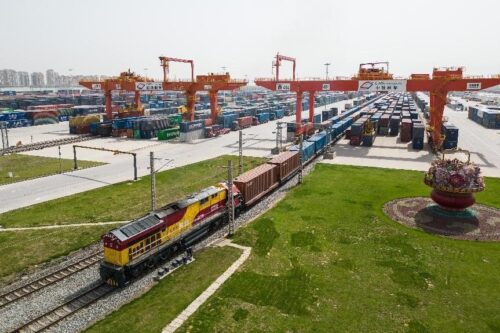
“Road” relates to a more logistically ambitious goal for China to access the Indian Ocean via complex corridors through South East Asia (particularly Myanmar) and via the adjoining Arabian sea through the Pakistan Economic Corridor. The westerly cities of Chengdu and Chongqing, which along with Xi’an form the “West Economic Triangle Zone”, are the gateways for this route. The BRI is therefore intended to increase China’s strategic resilience by reducing its reliance on the eastern and southern seaboards for exports. Of course, by reducing the cost and time to transport cargo from China westwards by rail to Europe, the BRI necessarily increases the attractiveness of western regions for foreign direct investment.
Although you wouldn’t know it from reading the papers, both foreign and local companies jumped at the logistical advantages of the BRI. The American company HP was an enthusiastic early adopter, proud to replace a 37-day journey from China to Europe eastwards by ship in 2009 with a 15-day journey westwards by rail ten years later. As a result between 2018 and 2019, rail volumes from Xi’an to Europe increased by a factor of 6! Then, in 2019 the volume of rail travel between Europe and China almost doubled. Suddenly, the western region boomed. And Xi’an was the place to be. In 2019, the government supported the rail project with an International Trade and Logistics Park along with a bonded area in an accompanying High-Tech Industrial Development Zone for cross-border e-commerce. Money poured in. Xi’an profited from US$31 billion of investment in private investment in 2019 alone. The city’s population grew from 6.2 million in 2013 to 8.8 million in 2023 and – despite the accelerated pace of construction – house prices rose 46% between 2016 – 2019. Similarly, the value of the city’s GDP or production tripled from US$57 billion in 2013 to US$156 billion in 2022. As a result of its fast population growth, Xi’an was able to extend its city limits and allocate more land to its fast-growing Qujiang District, where many of its new and soon to come luxury hotels are located. When I arrived in Xi’an in March 2023, having not been there since 2019, I was utterly astonished by the tail end of all that investment.

But Xi’an may well have hit its apogee just as Covid hit, because the pandemic has partly cut off the oxygen on which Xi’an thrived, namely foreigners’ access to the city. By June 2020, new business registrations had fallen by 40%. Tourism, along with equipment manufacturing and service outsourcing, was one of Xi’an’s pillar industries. Although domestic tourism provided some support, international tourism was completely interrupted from 2020 until March 2023, and because of reduced airlift to and from China, it is still only now beginning to recover. Furthermore, the conflict in the Ukraine and US sanctions on Russia have complicated Europe-bound rail logistics, though attempts are being made to create a new route that skirts Russia’s southern border across the Caspian Sea and the South Caucasus to Europe. Lastly, the economic and military standoff between China and the US has spilled into its relationships with Western Europe, Japan and South Korea, nullifying the Foreign Direct Investment on which Xi’an’s recent success and strategy has been predicated.
Following twenty years of continued investment Xi’an positively glistens. Expensively constructed government, commercial and residential buildings embellish a state-of-the-art infrastructural plan of social utopianist promise. However, tourism, a pillar industry, and reliance on continued foreign direct investment are being held hostage to the geopolitics of the moment. Without some kind of thaw in China’s relationship with western countries, Xi’an’s regeneration and even the ingenuity of the BRI are liable to stagnate. I and many Xi’an residents hope the world can find a way to avoid this fate.
As China’s big cities return to a new-normal, bars and restaurants are open, friends can meet and everyone is back to work. So, what about those wishing to take a break from everyday life and get away for a well-earned weekend? Of course, international travel is not really an option right now, but how has China’s domestic tourism market faired in these uncertain times?
The year of course began with considerable disruption due to the outbreak of the coronavirus, during which all of China’s many and varied tourist destinations were closed. By May 1st, however, China had long since declared victory over the virus and most of its world-famous sites were up and running again. Combined with the weekend, Labour Day (1st May) was a three-day holiday in China, of which many people took advantage.
In the first two days of the holiday more than 50 million trips were made, a respectable number by any calculation. In Beijing, the Forbidden City was partially open for the first time, albeit with limited ticket sales and social distancing measures maintained. In Shanghai, the city’s main tourist attractions welcomed more than 1 million visitors back, albeit initially operating at only 30% capacity and requiring visitors to wear masks. On the first day of the holiday, China’s railways carried 7.4 million passengers, the highest daily number recorded since the Lunar New Year holiday when the crisis began. Of course, one should bear in mind that these numbers were barely a quarter of the norm for this period, and there are many reasons for this. For starters, many people simply did not feel travel was yet worth the perceived risk. A nation that had been told to stay in their own homes for their own safety took a while longer to be lured back onto trains and planes.
Another reason may be linked to the path that China had taken out of lockdown, namely in its use of QR health codes. As mentioned in an earlier blog post “The Benefit of Experience in Tackling Covid-19”, most of China is now covered by a mandatory QR code system. To apply for the code, you register on an app such as Alipay, an e-wallet widely used in China, and enter information about your health, recent travel history, as well as ID information. This will give you a QR code: if green, you’re free to move around, but if your code changes to yellow, then restrictions including quarantine may follow. Each city generally has its own system and criteria, with differing consequences for varying colours. If a neighbouring city has confirmed covid-19 cases for example, travelers had reported that a visit may result in a yellow code and the need to self-isolate upon return. For a short trip from Shanghai to Hangzhou, just an hour away on the train, such potential uncertainty may have been off-putting even to locals. Accordingly, business travel reduced, with companies avoiding the risk of their employees getting stranded. However as things have moved on, it’s now possible to acquire multiple QR health codes, or codes which are compatible across cities. This has helped somewhat, allowing travelers to apply for clearance in advance, and has encouraged more people to get out and about.
Most hotels have now reopened, albeit not yet at full occupancy, but likely faring better than elsewhere. With temperature checks and facemasks having been commonplace for months, China’s travel industry is doing its best to help potential guests feel safe and secure away from home. Hand sanitiser is readily available everywhere.
For foreigners travelling within China, things have been a little more difficult. Until recently in fact, the Chinese Foreign Ministry had stopped issuing visas to China. These have since resumed, in a limited capacity and targeted to specific nationals only (mostly European). At present US passport holders are not granted visas for leisure travel. For those foreign nationals already in China – there can still be compatibility issues with QR codes, although the situation is improving as the system matures.
A month after the Labour Day holidays, a new outbreak did occur in Beijing. Then, over 1,200 flights were cancelled, train services greatly reduced and much of the city endured varying degrees of restrictions. However, roads remained open and people were allowed to leave once they had received a negative test result. Whereas this wave was quickly contained (as is to be expected by the swift action of local authorities now), mini-outbreaks have since occurred in Xinjiang Province and, even more recently, in Hong Kong which is currently at the tail end of its third wave. As a nation, the people are therefore much more alert – and uncertainties have affected mobility – but at the same time, most Chinese are confident that they’re currently in one of the safest places to be from the ongoing pandemic.
These days, China appears to be far ahead in getting life back to a new normal. Restaurants are buzzing and there is life on the streets. Air travel has recovered to pre-covid levels. In many parts, you can see people’s faces again, though masks are still required on most forms of public transport. Whatever setbacks might come in the near future, I don’t doubt that China’s tourism industry, along with other sectors, will bounce back quicker than most.
– Kate is one of Imperial Tours’ China Hosts and a Shanghai resident.
During these times when our faith in the future is questioned, it’s uplifting to be sent glimpses of societies that are further ahead in confronting Covid-19. China and Hong Kong had the misfortune to face their first coronavirus in November 2002. That gave them a head start in meeting the challenge set by this new disease. Kate, Imperial Tours’ Shanghai-based China Host, provides a snap shot of life in Hong Kong and the main cities of China’s mainland. She explains the technology and history underpinning their relative success in confronting Covid-19 and provides peace of mind by showing how – even before there is a vaccine – we can establish a new normal.
When Covid-19 first attacked, it appeared that Hong Kong was at great risk and likely to become inundated with cases. It has many land borders with the mainland and a huge influx of visitors crossing its borders every day, not to mention it being a transit hub for international flights from all over the world. Yet a lockdown never became necessary in Hong Kong. Why? Because Hong Kongers have been here before. These are people that have come through SARS and swine flu and they know the drill. So without the need for laws and lockdowns and police, the Hong Kong people started distancing from each other. They wore masks when they went outside and chose to stay home more. A survey in March found that 85% of people said they were avoiding crowded places, and 99% said they wore a mask if they went outside.
The government supported this effort by acting quickly and following WHO guidelines to test, test, test. They allowed just three crossing points from the mainland to remain open and introduced strict checks and quarantine measures for those arriving in the city. They stopped flights transiting. They also limited gatherings to a maximum of four people and required restaurants to separate tables and limit capacity to 50%. Bars and nightclubs were closed for a time, generally just 14 days. So, restaurants didn’t close, nor did daily life shutdown, yet with the willingness and cooperation of a people quick to play their part, Hong Kong maintained one of the lowest case-counts of the virus in the region.
At the time of writing, Hong Kong’s borders with the outside world remain closed to outside visitors and some restrictions remain in place. For example, it’s common to have your temperature checked and to see plastic screens separating tables in restaurants. However, people are gradually feeling safe to meet, now in groups of eight, as per current guidelines. Bars, beauty parlours and other leisure facilities are reopening and life is getting back to normal, albeit with the continued use of masks
At this point, bars and restaurants have reopened and patrons need not wear masks. In fact, only on public transport and in office buildings are masks widely worn indoors. Cinemas and other cultural events are operating at reduced capacity and if you fancy a swim you’ll need to book in advance. However, within those parameters, life is largely back to normal. Schools are slowly opening, people are travelling to work and socialising in the evenings. It appears China’s major cities have reached a new normal.

All residents use a QR code within Alipay or Wechat (If you haven’t heard of these platforms, you will have within five mnutes of arrival in China, it’s pretty much impossible to function on the Mainland without them. Think WhatsApp or Facebook but so much more necessary.) The system is pretty straightforward, you sign up with information about your health and where you’ve recently travelled. Then everywhere you go you scan the QR code, for example on a metro carriage or in a mall, and as a result of this you get given a traffic-light-based colour-code. A green code is your passport to freedom! Bars, restaurants, malls, whatever, you just show your green code at the door and in you go.
Now, it is worth pointing out that each city operating these codes has a separate system so the criteria and consequences differ slightly, but broadly speaking, if for any reason someone you’ve been in contact with later tests positive for the virus, your code turns yellow, at which point you’re required to self-isolate at home. You won’t have much option because with a yellow code no-one will let you in anyway. If you yourself develop symptoms and test positive, your code becomes red at which point you need to be in a government operated isolation facility. This method seems to be hugely effective, probably because of it’s ease of use and the willingness of the public to subscribe. The local transmission of cases has fallen to basically zero in all of the major cities. A secondary reason this system may be so effective, is that it makes a green code so valuable, that no-one wants to risk losing it. Therefore, the incentive to take unnecessary risks is reduced significantly
China has weathered an array of health crises since it’s opening up in 1979. From the Hepatitis A outbreak in 1988, to the much publicised outbreaks of SARS in 2002/03 and H7N9 in 2013 and now, the worldwide pandemic we all face. Yet as the virus persists and spreads from one hotspot to the next around the globe, in China, where the eyes of the world were so focussed just four short months ago, life is pretty much back to normal. That’s not to say there isn’t the occasional small outbreak, quickly contained and dealt with, or that people don’t remain cautious, but on the whole, the economy is moving, people are working, leisure venues are open and China is back.
So how did a country faced with a virus unprecedented in its transmissibility regain control in such a relatively short space of time? In short, the preparedness of the authorities and the willingness of the people.
The virus was widely recognised mid-January, shortly before the Chinese New Year holiday. This may have been a blessing in disguise, as, although huge numbers of people travel for the week long holiday, it made it relatively easy to close workplaces. China’s first line of defence was to lockdown Wuhan city, where the virus originated, closely followed by suspending intercity travel and extending the new year holiday in order to stop people moving around, taking the virus with them.
Increasingly strict measures followed nationwide. Neighbourhood committees (local “police” in charge of each residential area) became extra assertive, especially in Shanghai, where the rules imposed by the neighbourhood committees frequently went further than the national government guidelines. In Beijing, residents were advised to tell their local authorities of their impending return whereupon they would be asked to self-isolate for 14 days. In Shanghai, people could only sleep at the address at which they were registered and could not enter other apartment complexes for any reason. Masks became compulsory when leaving home, something which was only permitted for the purposes of buying essential supplies. Once the borders closed, anyone arriving at Chinese airports were subject to a mandatory quarantine, often in a designated hotel at their own expense. Those that were allowed to quarantine at home were escorted. As they walked from the vehicle to their home, teams in hazmat suits followed, spraying the ground behind them with disinfectant. Temperature monitors were placed on the returnees’ beds to check for a fever while they slept and sensors were placed on the front door of the apartment. If the door was opened for any reason the returnee would receive a text message asking for an explanation.
Extreme measures? Definitely.
Draconian? Probably.
Successful? Undoubtedly.
Just four months later, with its borders closed and rigorous testing in place, China is back in business.
– Kate is one of Imperial Tours’ China Hosts and a Shanghai resident.
If you haven’t yet read Part 1, click here to read about Jaime’s earlier experiences living through the Coronavirus quarantine in Beijing
“Last week there were five straight days without any locally transmitted infections in the entirety of China. Although that trend was bucked this Monday, it has been the case again today that the only new cases in the country are from individuals (Chinese or foreign: it isn’t known) who recently returned from abroad. Hubei province, which was the epicenter of the virus in China, has today announced that it will be lifting the travel restrictions that had been in place for two months, except for its capital Wuhan.
Things are far from returning to normal: thousands remain in hospital in serious condition and millions under varying degrees of curfew or quarantine measures. However, the vast majority of people across China can now go to work at their offices, exercise outdoors, dine with friends at restaurants and return home to their families with the hope that the worst part of the crisis has passed.

As the virus ricochets around the world, there are still stringent regulations in place to dissuade large groups of people congregating in case there are undetected clusters. The main tool that has been deployed in Beijing and other cities is the use of entry/exit cards. These are small cards which each local neighborhood issues and which must be shown upon leaving and entering the community. They have the user’s name and address, as well as in some cases a copy of the identity card on the reverse side to discourage misuse.
Most residential compounds in Beijing are gated, and each entrance is dutifully patrolled by volunteers working in shifts of a few hours each who check to make sure everyone coming in or out has a card, as well as their body temperature with a laser thermometer. This system has ensured a constant vigilance for potential new cases, and it has helped to ensure that the volume of interactions in any given area is lower than it would be otherwise. Likewise, restaurants and bars have a strict limit on the number of patrons they’re allowed to have on premises at any given time (my estimate is that the limit is 30% of capacity), with a maximum of 3 people seated together and ample space between tables. In what was surely meant as a symbolic gesture of confidence, one section of the Great Wall has re-opened to visitors after being closed for two months, albeit with the mandatory donning of face masks, temperature checks at the entrance and reduced visitor capacity.
Life is not normal in Beijing yet, far from it, but we can see it on the horizon. Whispers of movie theaters and museums starting to re-open are gaining credence and the steadily increasing flow of people on the streets (including a few risk-takers without masks) are for me all but certain signs that this city is steadily returning to its old self.
I sadden when I talk to friends in Italy, and I would rather not ponder too much on what awaits less-prepared countries around the world in the coming weeks, but I am absolutely convinced that if the world follows the instructions of health experts we will be able to get through the worst of this crisis in a much shorter span of time than we can imagine.”
– Jaime is one of Imperial Tours’ Itinerary Designers and a Beijing resident.
“With just three days until Chinese New Year, faced with the gradually spreading coronavirus epidemic, my husband and I decided to refund our New Year’s Eve train tickets to his home and to cancel plans to reunite with my in-laws for the ‘Spring Festival’, China’s most important holiday. Our family of three would stay in Beijing instead. Except for a meal with parents and sisters who were in Beijing for the Spring Festival, we could not visit restaurants or shopping malls, and could not meet with other relatives or friends. We wanted to relax, but our wandering minds couldn’t help but pay attention to news of the epidemic’s developments and to the extraordinary and heartbreaking efforts of medical staff in Wuhan – watching them was like wondering when a hanging heart would finally fall.
But life must go on. The Beijing city government encouraged employees to work from home and postpone visiting the office. My husband and I were uncertain when this 24/7 balancing act would end, so we set up a home office and with a baby to look after started the new Spring Festival holiday life.
Our five-year-old daughter doesn’t have a habit to sleep during the day, but hardly going out during the day, how could she consume all her energy at home and still fall asleep early in the evening? This was an issue that my husband and I discussed often. How long could the novelty of an indoor trampoline last? My husband and I took turns hopping with her before dinner to make it more fun. As children like to imitate adults, my husband and I followed an exercise app on our tablet for yoga and aerobics with our daughter. But in the end, my husband undusted the Xbox, having left it untouched for several years. Among the games, the dancing, skiing, and active themed ones became our family’s staple evening entertainment. Was this enough for our daughter to burn all her energy to be able to get to sleep early each evening? Not at all. Don’t even think about it! We relented and let her sleep later, so long as it didn’t affect daytime activities.
Family tensions did occasionally run high, but my daughter gradually submerged ever more deeply into her world of Lego and Peppa Pig dolls, curating themed and innovative scenes for them, arranging their respective characters for intense playtime. And when you grow tired of playing and start to get angry with your child, out come the fruit snacks to save the day. Free online children’s courses and newly acquired hobbies such as calligraphy and painting have become part of our lives. If your child is having a good time, then we adults can take advantage of the opportunity to do our own thing. After so many days of having “nowhere to escape”, I found the parent-child relationship remained mostly a mother-and-child bond. This cornerstone having been laid, it allowed my husband and I to run our household smoothly.
During the holiday, my frequent discussions of the virus and epidemic with my husband did not escape my daughter’s ears. We found a newly produced cartoon on viral sciences to watch and explain what was happening to our daughter. Gradually, she learned why our vacation had become so long without the resumption of her kindergarten; why her dad had to video conference from home; why she couldn’t play with her classmates; and why the courier couldn’t deliver direct to our home, but that an adult had to go downstairs to a special desk to collect deliveries. We had to explain why she couldn’t accompany her mother to the supermarket to choose her favourite snacks, not to mention hearing about the ‘uncle’ wearing protective clothing at the supermarket entrance taking everyone’s temperature before they can enter. My daughter would suddenly say: “Mom, I hope you can also be a doctor in the hospital.” Funnily enough, not long ago her kindergarten arranged a ‘virus prevention’ painting activity. My daughter’s piece was of ‘mother in the kitchen making tasty pies’, which she would eat to ‘strengthen her resistance’.
It is now the “Spring Equinox” season of the Chinese lunar calendar, where the weather outdoors begins to get warm and there is a feeling of summer approaching. As the fear of the virus recedes, the number of children playing downstairs in the community area is slowly increasing, and more and more restaurants around the city will gradually open for business. I believe our 24 hour ‘home life’ will soon be over.”
– Fiona is an accountant at Imperial Tours.
–Translated from Chinese by Terence Parker. You can read Fiona’s Chinese version here.
(You can read an English translation of this article here)
因得知疫情有逐渐蔓延的态势,离除夕还有两天的时候我和丈夫决定退掉除夕上午的火车票及取消和外地公婆春节团聚的计划,这个春节假期我们一家三口就继续留守北京度过吧。整个春节除了和同在北京的父母和姐姐一家聚餐外,不能去餐厅商场,没有走亲访友的聚会,想要专注的过个放松散漫的日子吧,却也常常“走神”关注疫情发展动态,武汉医院里那些非同寻常的医患事件牵动人心,悬着的心何时落地呢生活还要继续。得知市政府鼓励企业员工居家办公、暂缓开展全面复工的消息,我和丈夫觉得这7*24小时的居家工作带娃的生活模式还不知会何时结束,那么就先将散漫的春节假期生活作息逐步回归正轨吧。
五岁女儿倒没有早上睡懒觉的习惯,但白天几乎不出门又如何能在家消耗掉旺盛的精力进而晚上早入睡成了我和丈夫经常聊起的事。家里的蹦床没了新鲜感不跳了?那就饭前轮流陪她一起蹦能玩更嗨。孩子喜欢模仿大人做事?那我和丈夫跟着平板电脑里的运动app做瑜伽和跳操呗。后来丈夫更是找来尘封了几年的Xbox,其中的舞蹈滑雪等体感游戏成为晚间全家的娱乐项目。孩子这样就能充分放电天天早睡觉了么?不,你想都别想。好吧晚睡只要不影响白天好好玩耍就好,我们只能这样安慰自己。
经过和女儿快两个月的磨合,白天她扎堆在自己的乐高小猪佩奇和娃娃的世界里,为它们创建有主题和新意的场景,安排人偶各自的角色就能沉浸其中专注玩一个多小时。在玩疲乏或和娃娃生气发脾气的时候,水果小零食就拿出来救救场。免费网络幼儿在线课程及新购入的手工材料书画颜料等也穿插到生活其中。孩子玩得舒心,大人也能趁时机做些自己的事。这么多天的“无处可逃式”的相处下来,亲子关系总体还算是”母慈子孝“,这个基石奠定好了,我和丈夫更能顺利安排好居家的工作。
春节时期和丈夫常聊起的病毒及疫情的话题也自然都逃不掉女儿的耳朵,有媒体制作出了病毒科普动画也找来给女儿观看并讲解。逐渐的,她知道了为什么假期会延长那么久而自己不用去幼儿园,爸爸为什么在家用电脑开视频会也是上班;为什么不能再去隔壁的小区找同班小朋友玩;为什么快递员叔叔不能再送货上门而是要大人们下楼到小区于管控期间唯一的出入口取走快递;为什么不能再和妈妈一起去超市亲自去买想吃的零食,而听说超市门口还有穿防护服的叔叔给大家测量体温后才能进入;更会突然说“妈妈,我也希望你是医院里给人看病的医生可以么。”女儿幼儿园前不久组织的“防疫小卫士”绘画活动,女儿上传的作品内容是妈妈在厨房做好吃的馅饼、我吃了能增强抵抗力。
现在已是中国农历“春分”的时节,白天的室外天气早已是暖风拂面夏天将至的感觉,小区楼下玩耍的孩子们也逐渐增多;周围也有餐厅逐步开放营业,相信这种24小时居家生活状态和快就会结束了吧。
Updated: 25 March 2020
The Imperial Tours team would like to extend their heartfelt solidarity to everyone around the world who is being impacted by Covid-19. Now more than ever we are reminded of how fortunate we are to be in a business which brings people from opposite sides of the world together. To our amazing partners in the travel sector, we would like to remind that these difficult times will pass and that we will continue to arrange inspiring trips for our guests at the appropriate time. We put the health of our clients first and foremost and when travel to and within China resumes, we will proceed with our tours only if we are sure that there are absolutely no health risks to our guests.
While borders around the world keep closing and travel grinds to a halt, the Imperial Tours team is still very much at your disposal for any existing or future travel inquiries, as well as for on-the-ground updates on how the situation in China is evolving. As China was the first country hit by the pandemic, it is also now fortunate enough to be on the other side of the curve. If you would like to read some uplifting perspectives on the speed with which we can recover from the pandemic be sure to check our Blog in which our staff share their observations of positive developments in China.
If you or your client’s travel to China through Imperial Tours has been impacted by Covid-19, our updated policy is as follows:
FOR ALL TRIPS DEPARTING BEFORE AUGUST 31st 2020
In compliance with restrictions and advisories worldwide, Imperial Tours has temporarily suspended all tours departing until August 31st2020. If you have a tour scheduled for these dates, we offer the following options:
OR
OR
If you have any questions please feel free to contact the Itinerary Designer you have been working with or send us an email to this address.
““One hundred and ten!” one of my neighbors yelled proudly from our shared common courtyard. He had been walking around the inside perimeter of our block of flats for the better part of an hour, phone in one hand and a leash connecting him to his sluggish corgi in the other. Face covered with the now obligatory mask, he walked over towards another dog-neighbor duo sitting on a bench enjoying the spring sun and in his booming voice announced he was increasing his loops by 10% each day. The neighbor didn’t bother to mutter a response, and the man’s corgi, unimpressed, quickly slumped alongside his fellow canine.
I am ignorant of what constituted my neighbor’s exercise routine before Covid-19, but Beijing has implemented such restrictive measures on movement that most people are weary to leave their homes except for pressing reasons. Having lived in the historic center of Beijing for almost ten years now, the changes have been unlike anything I’ve ever witnessed. The maze-like hutongs (alleyways) used to have shoulder-to-shoulder crowds of people flocking to the restaurants, bars, shops and tourist attractions of the area. These are now all sealed off with a retractable fence at every possible entry point and manned day and night with at least two, typically middle-aged, volunteers. Working in shifts of two hours, they are armed with a walkie-talkie, a laser thermometer and, most importantly, a sense of duty for collective action against a common enemy, this new virus. A large percentage of restaurants and bars remain closed, and anywhere which may be a focal point for crowds has been shut. The main exception is public parks which, to the relief of many, have kept their doors open to visitors so long as they don a mask and agree to a temperature check.
Although these measures were greeted by skepticism around the world when they were announced, the numbers should be enough to placate doubts of their effectiveness. The early days of February when thousands of new cases were being diagnosed on a daily basis are now unthinkable, and the trickle of cases that continue to emerge -outside the epicenter of Hubei- are mostly imported by travelers returning from one of the other large clusters around the world. As of this week they are being quarantined in specially designated hotels, so while they are mostly returning residents and not luxury travelers to China, measures like this will affect travelers for some time to come. Nonetheless, the drastic downward trend in cases is a welcome respite from the early days of the virus spread, and countries where the virus still looks to be gaining momentum should get some reassurance from it.”
You can now read Part 2 for a follow up of Jaime’s experiences living through the quarantine in Beijing.
– Jaime is one of Imperial Tours’ Itinerary Designers and a Beijing resident.